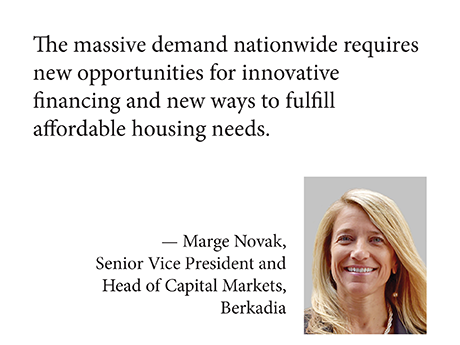In May, The White House announced its Housing Supply Action Plan to address rising housing costs by increasing the supply of housing in communities across the country over the next five years. The plan aims to create more housing of all asset types through new construction and preservation and singles out the importance of affordable housing, particularly in a time of high interest rates and inflation.
The COVID-19 pandemic and the ensuing economic fallout have uniquely impacted renters unlike previous times of economic uncertainty. Renter demand and rental rates have increased at the fastest pace in decades, underscoring the importance and urgency of increasing the stock of affordable rental housing.
The Housing Supply Action Plan does just that. Specifically, the plan seeks to finance more than 800,000 affordable rental units by expanding and strengthening the Low-Income Housing Tax Credit (LIHTC) program.
Similar language was included in the Build Back Better Plan, which included a variety of actions aimed to bolster the lower and middle class with investments in housing, infrastructure and labor markets. This important piece of the proposed legislation would significantly increase resources that will ultimately expand the number of affordable units available.
The Housing Supply Action Plan includes the following proposals related to the housing tax credit:
- lowering the bond-financing threshold from 50 percent to 25 percent for five years, from 2022 to 2026;
- increasing the annual housing LIHTC allocation at a rate of 10 percent per year plus inflation from 2022 to 2024, which amounts to a roughly 41 percent increase over current levels in 2024, followed by inflation adjustments after 2025;
- providing a permanent 50 percent basis boost for properties serving extremely low-income (ELI) households, along with an 8 percent set-aside for properties taking advantage of the ELI basis boost, as well as a limitation on the amount of allocation and volume cap that can be used for properties receiving the ELI boost; and
- providing a permanent 30 percent basis boost for properties in Indian country.
There’s an immense opportunity with the proposed Housing Supply Action Plan. However, it also brings challenges that the industry must work together to navigate.
With additional tax credits entering the market, we need to properly manage them in a way that balances investor returns with investment dollars to developers. With the increased investment, it’s imperative that the market pricing and returns remain steady.
Safe, quality, affordable housing helps reduce poverty and increase economic mobility. The growing demand of affordable rental units and inadequate supply is garnering more interest and investment in the affordable housing sector.
This lines up with investors’ environmental, social and governance (ESG) goals. Investors are seeking more opportunities that make an impact on the communities where they work and invest. Affordable housing qualifies as an ESG investment.
Additionally, as illustrated by COVID-19, investing in affordable housing is relatively low risk as compared to other multifamily subclasses. This is of particular interest as we continue in this volatile market.
After working in affordable housing for 30 years, I can honestly say that there has never been a more exciting or more important time to invest in affordable housing. The massive demand nationwide requires new opportunities for innovative financing and new ways to fulfill affordable housing needs.
I am thrilled about the steps we are making toward bridging the gap in affordable rental housing supply and demand, but I am also aware of the additional work that we need to do to ensure that everyone has access to quality housing.
— By Marge Novak, senior vice president and head of capital markets for Berkadia. Novak has more than 25 years of experience in the Low-Income Housing Tax Credit (LIHTC) program. Prior to joining Berkadia, Novak served as executive vice president at Cinnaire, where she led the company in raising $1.8 billion in LIHTC equity.


